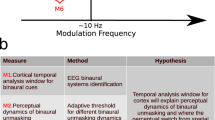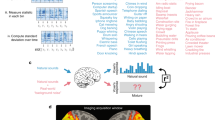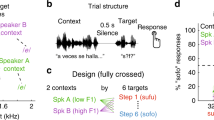Abstract
Humans and owls localize sounds by detecting the arrival time disparity between the ears. Both species determine the interaural time difference by finding the delay necessary to match the leading signal with the lagging one. This method produces ambiguity with periodic signals, because the two signals can be matched by delaying either one or the other. As predicted, owls localized periodic signals in illusory directions, whereas they always perceived the real source when signal bandwidth exceeded a certain value. This bandwidth also enabled higher-order auditory neurons to discriminate between real and illusory sources.
This is a preview of subscription content, access via your institution
Access options
Subscribe to this journal
Receive 12 print issues and online access
$209.00 per year
only $17.42 per issue
Buy this article
- Purchase on Springer Link
- Instant access to full article PDF
Prices may be subject to local taxes which are calculated during checkout




Similar content being viewed by others
References
Jeffress, L. A. A place theory of sound localization. J. Comp. Physiol. Psychol. 41, 35–39 (1948).
Jeffress, L. A. in Binaural Signal Detection: Vector Theory. Foundations Of Modern Auditory Theory Vol. 2 (ed. Tobias, J. V.) 349–368 (Academic, New York, 1972).
Sayers, B. M. & Cherry, E. C. Mechanism of binaural fusion in the hearing of speech. J. Acoust. Soc. Am. 29, 973–987 (1957).
Carr, C. E. & Konishi, M. Axonal delay-lines for time measurement in the owls brain-stem. Proc. Natl. Acad. Sci. USA 85, 8311–8315 (1988).
Carr, C. E. & Konishi, M. A circuit for detection of interaural time differences in the brain stem of the barn owl. J. Neurosci. 10, 3227–3246 (1990).
Overholt, E. M. & Rubel, E. W. & Hyson, R. L. 1992. A circuit for coding interaural time differences in the chick brainstem. J. Neurosci. 12, 1698–1708 (1992).
Yin, T. C. & Chan, J. C. Interaural time sensitivity in medial superior olive of cat. J. Neurophysiol. 64, 465–488 (1990).
Smith, P. H., Joris, P. X. & Yin, T. C. Projections of physiologically characterized spherical bushy cell axons from the cochlear nucleus of the cat: evidence for delay lines to the medial superior olive. J. Comp. Neurol. 331, 245–260 (1993).
Oertel, D. The role of timing in the brainstem auditory nuclei of vertebrates. Annu. Rev. Neurosci. 61, 497–516 (1999).
Stern, R. M., Zeiberg, A. S. & Trahiotis, C. Lateralization of complex binaural stimuli: a weighted-image model. J. Acoust. Soc. Am. 84, 156–165 (1988).
Colburn, H. S. Theory of binaural interaction based on auditory-nerve data: I. General strategy and preliminary results on interaural discrimination. J. Acoust. Soc. Am. 54, 1458–1470 (1973).
Colburn, H. S. in Auditory Computation (eds. Hawkins, H., McMullen, T., Fay, R. & Popper, A. N.) 332–400 (Springer, New York, 1995).
Saberi, K., Farahbod, H. & Konishi, M. How do owls localize interaurally phase-ambiguous sounds? Proc. Natl. Acad. Sci. USA 95, 6465–6468 (1998).
Moiseff, A. & Konishi, M. Neuronal and behavioral sensitivity to binaural time differences in the owl. J. Neurosci. 1, 40–48 (1981).
Mazer, J. How the owl resolves auditory coding ambiguity. Proc. Natl. Acad. Sci. USA 95, 10932–10937 (1998).
Mazer, J. Integration of Parallel Processing Streams in the Inferior Colliculus of the Barn Owl. Thesis. Caltech (1995).
Saberi, K. et al. Effects of interaural decorrelation on neural and behavioral detection of spatial cues. Neuron 21, 789–798 (1998).
Saberi, K. An auditory illusion predicted from a weighted cross-correlation model of binaural interaction. Psychol. Rev. 103, 137–142 (1996).
Saberi, K. Modeling interaural-delay sensitivity to frequency modulation at high frequencies. J. Acoust. Soc. Am. 103, 2551–2564 (1998).
Konishi, M. How the owl tracks its prey. Am. Sci. 61, 414–424 (1973).
Hafter, E. R. & Shelton, B. R. Counterintuitive reversals in lateralization using rectangularly modulated noise. J. Acoust. Soc. Am. 90, 1901–1907 (1991).
Grantham, D. W. in Spatial Hearing and Related Phenomena. Handbook of Perception and Cognition: Hearing (ed. Moore, B. C.) 297–345 (Academic, San Diego, 1995).
Takahashi, T. T. & Konishi, M. Selectivity for interaural time difference in the owl's midbrain. J. Neurosci. 6, 3413–3422 (1986).
Shackleton, T. M., Meddis, R. & Hewitt, M. J. Across-frequency integration in model of lateralization. J. Acoust. Soc. Am. 91, 2276–2279 (1992).
Trahiotis, C. & Stern, R. M. Across-frequency integration in lateralization of complex binaural stimuli. J. Acoust. Soc. Am. 96, 3804–3806 (1994).
Wagner, H., Takahashi, T. & Konishi, M. Representation of interaural time difference in the central nucleus of the barn owl's inferior colliculus. J. Neurosci. 7, 3105–3116 (1987).
Keller, C. H. & Takahashi, T. Binaural cross-correlation predicts the responses of neurons in the owl's auditory space map under conditions simulating summing localization. J. Neurosci. 16, 4300–4309 (1996).
Mori, K. Across-frequency nonlinear inhibition by GABA in processing of ITD. Hear. Res. 111, 22–30 (1997).
duLac, S. & Knudsen, E. I. Neural maps of head movement vector and speed in the optic tectum of the barn owl. J. Neurophysiol. 63, 131–146 (1990).
Acknowledgements
This work was supported by NIH (National Institutes of Deafness and Other Communicative Disorders) and a Human Frontier Science Program Fellowship (Y.T.). We thank John C. Middlebrooks, Terry Takahashi and Ervin R. Hafter for commenting on an earlier draft of this paper. We also thank Roian Egnor for comments and assistance during the course of this research.
Author information
Authors and Affiliations
Corresponding author
Rights and permissions
About this article
Cite this article
Saberi, K., Takahashi, Y., Farahbod, H. et al. Neural bases of an auditory illusion and its elimination in owls. Nat Neurosci 2, 656–659 (1999). https://doi.org/10.1038/10212
Received:
Accepted:
Issue Date:
DOI: https://doi.org/10.1038/10212
This article is cited by
-
Side peak suppression in responses of an across-frequency integration model to stimuli of varying bandwidth as demonstrated analytically and by implementation
Journal of Computational Neuroscience (2014)
-
Is the free-energy principle neurocentric?
Nature Reviews Neuroscience (2010)
-
Target-approaching behavior of barn owls (Tyto alba): influence of sound frequency
Journal of Comparative Physiology A (2010)
-
Sensitivity to interaural time difference and representation of azimuth in central nucleus of inferior colliculus in the barn owl
Journal of Comparative Physiology A (2007)



